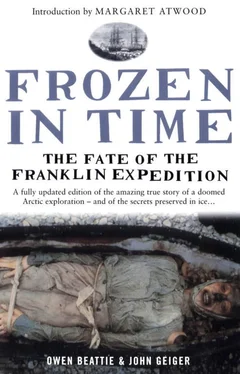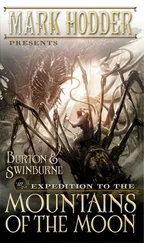As they approached Rivière de la Rocquette across a dismally flat landscape, two small objects caught their attention. The first was a small grey lump in their path, which soon revealed itself to be a young Arctic hare, or leveret. Born fully haired, with their eyes wide open, hares are able to run just minutes after birth. This tiny, gentle animal stood out in stark contrast to the forbidding landscape. It was rigid with fright, its heart pounding. The four watched it for a time, took some photographs, then continued on. The second object turned out to be what was almost certainly an Inuit artefact, constructed from material collected in the nineteenth century from a Franklin site. It resembled a primitive fishing rod made of two pieces of wood and twine; the wood held together in part by a brass nail. It was a good example of the use made by the Inuit of abandoned European artefacts.
Surveying the coast had largely meant walking along beach ridges of limestone shingle and sloshing through shallow sheets of water draining off the island. Now, as they held up their hands to shade themselves against the sun, the team could see the other side of Rivière de la Rocquette, ⅓ mile (.5 km) to the southwest; beyond that point the land was too flat to pick out any landmarks. The river itself posed a considerable obstacle, and there was discussion as to whether they should attempt to walk round it, out on the ice of Erebus Bay. However, earlier that day they had been able to see the effect of the river’s flow on the ice in the bay. The volume of water had pushed it far offshore, and the ice that could be seen through binoculars did not look inviting. Finally, all agreed that to walk out on that rotten ice would be too dangerous; the river would have to be waded.
Beattie recalled the vivid description of Schwatka’s group when they had stood on the same spot 103 years before: at that time the river was considered impassable down near its mouth, and the group had to hike inland a number of miles to where the river narrowed and they could cross in icy-cold, waist-deep water. Beattie wondered how he and his crew, far less rugged and experienced than Schwatka’s men, would fare in gaining the far bank. Carlson and Tungilik had hip waders, which they untied from their backpacks and put on. Kowal donned pack boots that reached to mid-calf and began slowly wading out into the shallow edge of the river, searching carefully for submerged banks of gravel that would allow him to keep the water from rising above the boot tops. Tungilik struck out along the same route. Carlson and Beattie unpacked and began inflating a two-man rubber boat that they had carried (along with a set of oars) since their survey began. They planned to use it to float their supplies across the river, but Beattie also hoped to find a way to keep his feet dry. As he had only pack boots himself, it seemed reasonable to have Carlson, in his hip waders, pull him across the river in the boat. Kowal was too far away for the others to see if he was having success in keeping dry, and the wind and distance were too great to shout to him.
Carlson and Beattie had problems inflating the boat with the rubber foot pump, and when the craft was half-inflated, the pump ceased working altogether. Despite having a rather floppy, unmanageable water craft at his disposal, Beattie loaded his pack and climbed in. He quickly found himself floundering—before finally tumbling over on his back with his legs sticking up in the air. After a good laugh, he righted himself and, soaked, climbed out of the boat. He and Carlson started wading slowly across after the others, the empty and limp boat bobbing and swivelling downstream from a rope attached to Carlson’s pack. The water turned out to be very shallow almost the whole distance across, though within 160 feet (50 metres) of the other side it increased to knee depth.
Resting by a rock near the river bank the four looked off to the west across a forbidding 6 miles (10 km) of mud flats. Their next stop would be the food cache that had been dropped from the plane on the first day of the season. They needed to replenish their supplies: over the past two days they had virtually run out of food and fuel, and they were looking forward to the supplies they had packed in the distant cache. So, thinking as much about their empty stomachs as the obviously difficult walk before them, they struck out onto the grey-brown featureless mud flats.
The clay-like mud had melted down 4 inches (10 cm) or more and was softy and pasty. Each footstep squeezed the mud out like toothpaste, and the friction and suction made extracting their feet a struggle. At first they sank in only up to their boot tops, but as they pushed a few more miles out onto the flats, there was more water in the mud. Now their feet sank down to the permafrost. The grip of the mud, sometimes ankle-deep but at other times more than knee-deep, was so strong that they often pulled their feet right out of their boots.
At times they would encounter an island of vegetation where the footing was good, and at each of these spots they would take a short rest before plunging into the mud again. In one of these “islands,” the intact skeleton of a bearded seal was found. Virtually undisturbed by animals, it looked almost surreal against the backdrop of the mudflats.
Halfway across they began to see the slightly raised beach ridge that marked the location where they had dropped their cache, and two hours later, when they finally started up the nearly imperceptible slope of the western extent of the flats, they were within only a few miles of their next camp. When at last they reached firm ground, they threw their packs down and sat to rest their legs.
It had taken more than four hours to cross the flats. Although the cold wind blew persistently off the ice at Erebus Bay, the day was sunny and warm, nearly 50°F (10°C), and before long all were lying on their backs, soaking in the sun, thankful that they did not have to return by the same route. Twenty minutes passed with hardly a word said before one of them, Carlson, finally sat up and busied himself with his pack. Their bodies now rested, stomachs began to growl; the next goal was the cache.
Walking to the west they dropped quickly down into another flat area, but this one was only two-thirds of a mile across and had good footing. Several pairs of whistling swans, which had constructed their large nests here, could be seen nearby, and the four men paused to observe the large and majestic birds before continuing on their long walk. Then, in the middle of the flats, Tungilik stopped dead and, pointing at the ground, asked Kowal, “What’s this bone?” Kowal was shocked to see a right human tibia lying on the surface of the flats. He called to Beattie and Carlson, who had been following. As the others hurried towards them, Kowal decided to have some fun. He quickly covered the bone with a piece of driftwood. When Beattie and Carlson finally arrived, both panting under the weight of their packs, Kowal said, “Look at this!” Beattie looked down at the wood and said, “You made me hurry up for this?” Then, turning the wood over with his foot, a broad smile crossed his face. All thoughts of reaching the food cache quickly vanished as the team searched the location for other bones. Five more were found nearby, as were two weathered pieces of wood planking, one of which had remnants of green paint, a brass screw and badly rusted iron nail shafts. Because the six bones were from different parts of a skeleton, it seemed likely that they were from one person. However, since none of the bones was from the skull, it was not possible to tell whether the person was a European or Inuk, though the bones were close enough to the location of the lifeboat first found by M’Clintock that they were most likely those of one of Franklin’s men. The wood planking supported this interpretation.
Читать дальше










